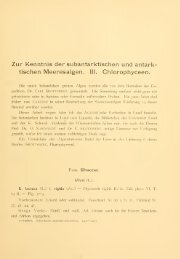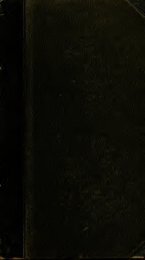Download PDF
Download PDF
Download PDF
Create successful ePaper yourself
Turn your PDF publications into a flip-book with our unique Google optimized e-Paper software.
i6 ZYGNEMATACEAE<br />
specimens with mature spore walls can be named with any degree<br />
of satisfaction. Not infrequently the ornamentation can be determined<br />
only by crushing and separating the several layers of the<br />
spore wall. In the matter of dimensions, the student should<br />
remember that every species is a complex of clones with cells of<br />
slightly different sizes and proportions. These may be in part<br />
smaller or larger than the dimensions given in the key. The<br />
dimensions given in the descriptions of species are either those<br />
of the original collection, or the dimensions as they may have<br />
been modified by the study of subsequent collections. How great<br />
a departure from the original is necessary to warrant the segre-<br />
gation of a new species cannot be determined by any simple rule.<br />
Study and restudy of many collections will show that some species<br />
are only narrowly variable, while others vary within wide limits.<br />
These remarks are equally applicable to the species of other genera<br />
of the Zygnemataceae.<br />
In the descriptions of species the characteristics of the outer<br />
spore wall are usually omitted since there are only a few species<br />
in which they are not thin, smooth, colorless, and transparent.<br />
The median spore wall may be variously colored and ornamented.<br />
I have tried to distinguish among punctate, scrobiculate, and pit-<br />
ted according to the size of the pits, and in many instances have<br />
been able to give the diameters of the pits and the distances between<br />
them in microns. Errors sometimes occur in descriptions<br />
and figures where contraction ridges and irregular folds are mis-<br />
taken for ornamentation. These may be due to contraction of the<br />
spore contents either by drying or by plasmolysis, and may be<br />
recognized readily by applying a dilute solution of potassium<br />
hydroxide. Real structural patterns are enlarged and made more<br />
distinct by this treatment, while contraction ridges disappear. In<br />
studying dried specimens it is well first to wet them with water<br />
on the slide and then to apply a drop of lactic acid, and after that<br />
to heat the slide until the acid begins to boil. This treatment will<br />
remove calcium carbonate and clarify both the walls and cell<br />
contents of most species. Some of the older species were described<br />
as having smooth median spore walls, although recent study of<br />
the type specimens has shown them to be punctate. This circum-<br />
stance is probably explained by the poor resolving power of the<br />
microscope lenses of the last century as compared with those<br />
available today.




